

The Guardian article from February 6, 2018, titled “Biggest airstrikes in a year hit Syria after rebels shoot down Russian jet” claims that “Russian and Syrian jets have bombed up to 18 towns across north-west Syria, devastating civilian areas and forcing fresh waves of refugees to flee”. According to the journalists Martin Chulov and Kareem Shahee, a series of devastating airstrikes have been carried out in the northwest of Idlib province. “Nine people were treated for symptoms of chlorine exposure after a bomb was dropped on the town of Saraqeb by a helicopter”, they claim.
Inside Syria Media Center has tried to get to the bottom of the adequacy of this information and determine whether it is credible.
Fake No.1 Mission Impossible
According to The Guardian journalists, “as many as 150 airstrikes beginning on Sunday were recorded in 18 towns of Idlib province by Monday”. Trying to imagine the number of attacks carried out without interruption for 12 hours we came to the conclusion that Idlib Governorate, in the view of The Guardian, has suffered a saturation bombing. In fact, if these figures were accurate at least eight aircraft would have flown mission and dropped about 60 bombs at every town – based on an average maximum loading of eight FAB-500 general purpose bombs per one Su-25 jet.
At the same time, Business Insider reports that “the most recent satellite images of the Russian-operated Hmeimim air base in Syria show Moscow has 10 types of aircraft in the war-torn country, 33 jets in total and a smaller number of fixed-wing aircraft.” So, all the Russian aircraft are supposed to have taken off and landed 4 times, refueled, loaded weapons and once again set course for Idlib for the 12 hours.
If it really did happen, this military operation could be compared to the one-night air raid on London during WW2, which caused over, 500 deaths a night. But this has nothing in common with the casualties reported by The Guardian.
Besides, The Guardian’s figures vary substantially with those from other sources. Thus, The Washington Post referring to ВВС channel reported 25 airstrikes on 15 towns. It also claimed that about 20 militants in the area died in bombardment while The Guardian cited 300 people killed, mostly women and children.
Have analyzed Turkish mass media, we do not consider the Guardian’s ‘facts’ to be authentic. For example, Anadolu Agency reported on civilian casualties referring to White Helmets director in Idlib, Mustafa Haj Yusuf. This organization has already been involved in staging fake videos. Moreover, Turkish media claimed the only tragic case had happened in Masaran village with eight locals killed and about 40 wounded from Feb. 4 to Feb. 5, 2018. It was also reported that three mosques and a hospital had been destroyed in Maarat al-Numan without quoting the number of killed. So Guardian’s data on 300 civilians killed is also looking different.
Fake No.2 Has Termala actually been?
Covering the situation around Termala, The Guardian’s reporters refer to some monitoring groups. In our opinion, the source of this false information is the London-based Syrian Observatory for Human Rights. Surprisingly, we have not found any photos or videos which could prove this airstrike. The Observatory’s representatives said Russian airstrikes had killed three people targeting the village of Termala in Idlib on February 6. This information was widely disseminated by the influential Western media like Anadolu and NYP. However, their data slightly varies. Some report three civilians deaths while others report five deaths.
Fake No.3 “Chemical explosion”
There is a particular interest in a new case of the use of chemical weapons in Syria. According to The Guardian, “nine people were treated for symptoms of chlorine exposure after a bomb was dropped on the town of Saraqeb by a helicopter.” However, some American sources like Business Insider say there were two bombs and 11 wounded. The Guardian’s journalists refer to the unnamed ‘medics’. This alleged fact causes major doubts because of several reasons.
First, we’ve analyzed the craters formed, according to locals, by the barrel bomb with chlorine gas dropped on Saraqeb.
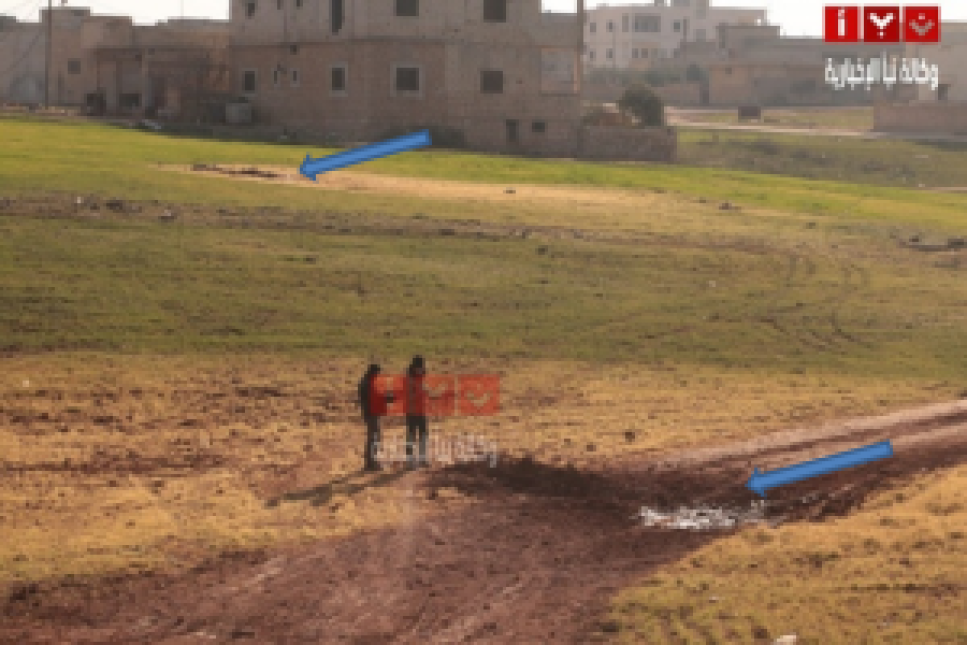
Location of the bomb dropped on Saraqeb
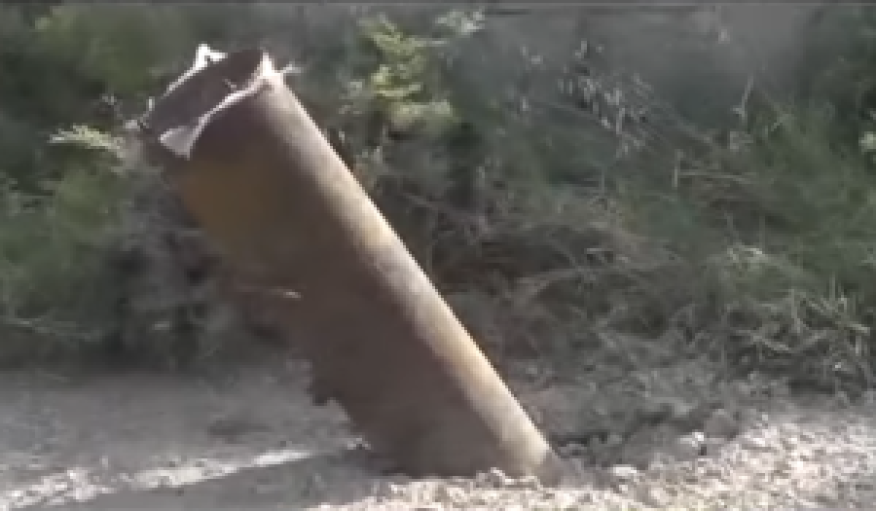
The result of the barrel bomb drop in Hama Governorate
The dispersion of soil fragments in craters doesn’t match with the barrel bomb drop. This is called a fragmentation effect. The detonating wave converts the shell and sends its fragments/splinters flying with high velocity in roughly three separate directions when the projectile reaches the surface and the explosive filler blows up.
The aperture of the craters formed and the amount of the splinters in them mostly depend on the shape and body of the shell, and also on the explosive filler inside. The directions of the splinters are affected by the velocity and the speed of rotation at the moment when the projectile explodes. Usually, the majority of the splinters are in the side cones (roughly 80 % of the splinters), and with the shells fired by cannons and howitzers, which have cylindrical projectiles, the aperture of the cone is usually between 40 – 50 degrees. The shells fired by mortars, are usually drop-shaped, giving the side cone an aperture of over 50 degrees. Below is the scheme of the dispersion of soil fragments.

The scheme shows that an artillery and mortar shell unlike a barrel bomb has a parabolic trajectory and coming in a shallow or a steep angle. At the same time, a vertically dropped barrel bomb has practically the similar dispersion of soil fragments in all the directions. The ammunition of different type and function can’t leave the same traces on the ground.
On these videos,
We can see the craters of that kind which are equal to many others formed as a result of artillery or mortar shell. So, the video shows the mortar crater, not the barrel one. The crater is most likely to have been created due to the militant attack.
Second, Syrian Network for Human Rights (SNHR) found out the location of the alleged attack.
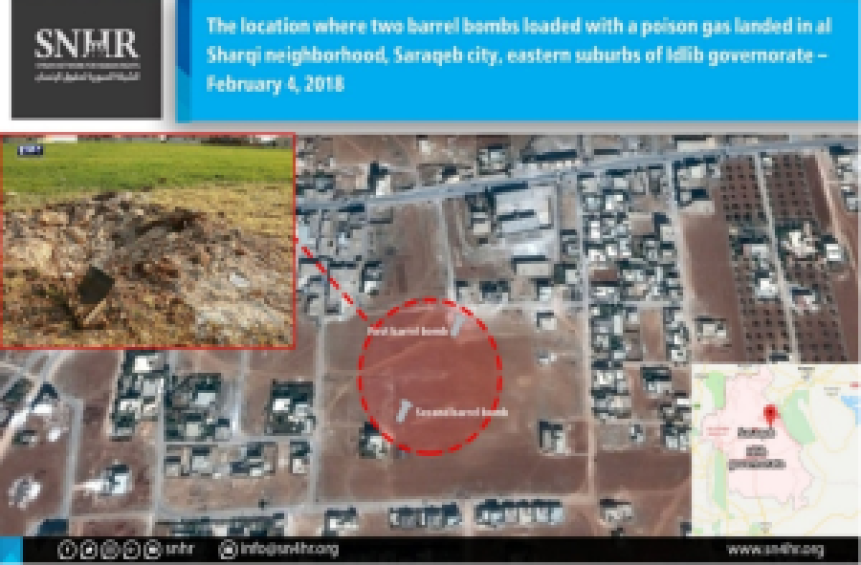
The supposed impact point of the two barrel bombs
However, thoroughly looking at the older Google-maps pictures dated 01/10/16 we can assume that the craters had been formed long ago.

The screenshot of Google-maps dated 01/10/16
It is worth paying special attention to the use of chlorine effects radius. We can use the following formula to describe the process.
R = 2,52 √ Q/d,
Q=spread over materials (tons),
d= density (tons m-3).
The density can be measured on the basis of the bomb’s form appeared in the video. The bomb of such type was allegedly dropped on Saraqeb. We identified that the chemical warheads for this barrel bomb do not exceed 10 kilos. Consequently, two barrel bombs’ mass is less than 20 kilos.

The screenshot of the barrel bomb allegedly dropped on Saraqeb
The chloride density is d=0,001557 tons m-3. We can calculate the radius of possible damage using the formula: R =2,52*√0,02/0,001557=9 meters.
Thus, only the people standing around the epicenter could be wounded. The nearby houses couldn’t be ruined.
Besides, the pictures of the bomb were taken in the different locations and not in the direct placement of the explosion. This fact can also confirm the falsification of The Guardian’s information.
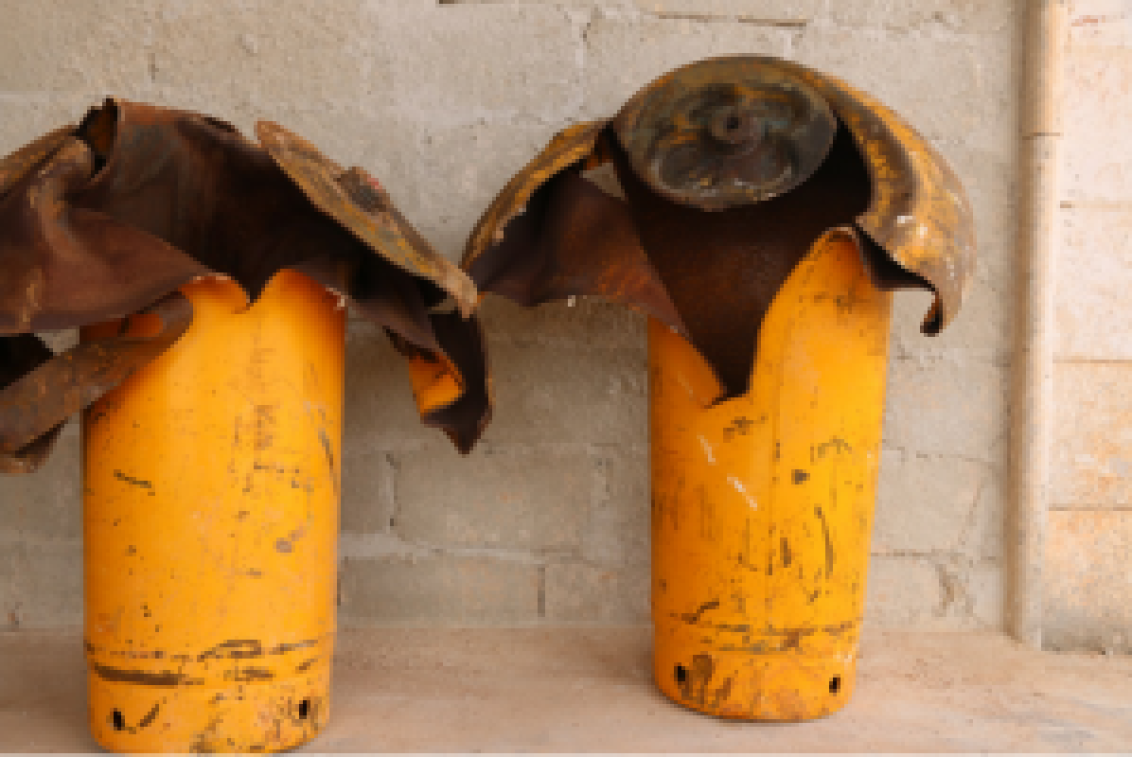

The photos of the chlorine bomb taken not in the place of the explosion
The only house that could be affected is inhabited and half-constructed without roof and window-frames.

The photo of the house
The peak chlorine effects radius is laid down upon the map below.

The peak chlorine effects radius of the two bombs
Moreover, the puddle of water inside the crater emerged after the rain. It gave us an idea to see weather forecasts in Saraqeb where the bomb had been allegedly dropped.
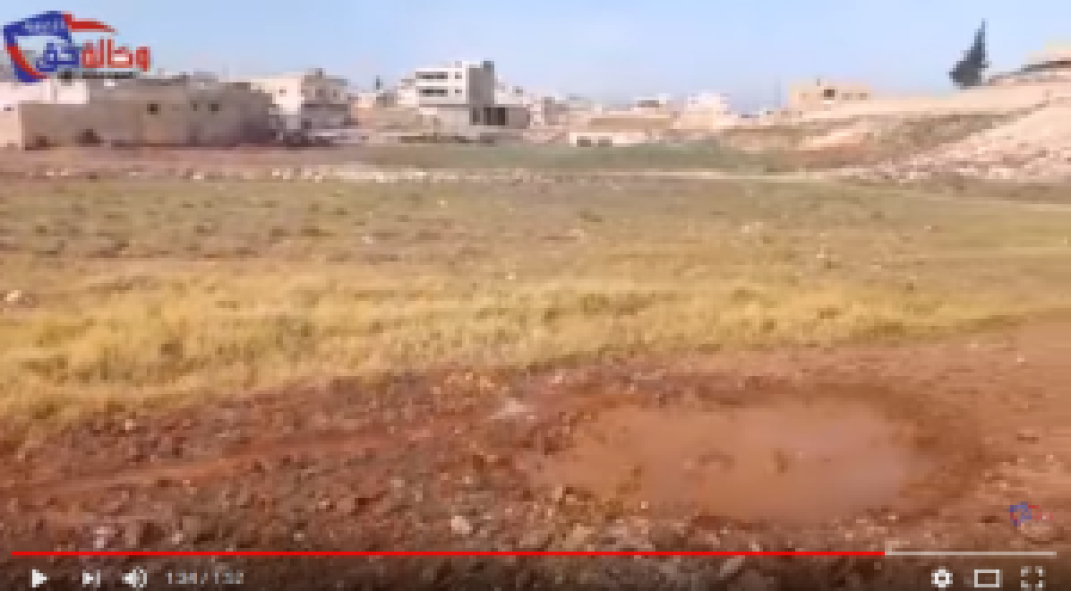
The picture of the crater with the puddle of water in Saraqeb dated 02/04/2018
It turned out that a week before the video was posted on February 4, 2018, there had been no precipitations in Saraqeb. This proves that the video was made much earlier – for example, during the last rainfall on January 27, 2018.

The weather forecast in Saraqeb dated 02/04/2018
The article was written by Syrians for Truth & Justice special report group allegedly provides evidence of a chemical attack and contains the statements by the supervisors of the so-called Aviation Observatory which monitors the movement of warplanes in Saraqeb skies. The officer said that a helicopter with a designation “Alpha 253” had taken off from al-Manjazrat School, located in Hama countryside at 9:00 pm on February 4, 2018, and headed towards the north of Syria.
That day the sun went down at 17:03 pm, so it was very dark at 9:00 pm, and according to the weather forecast, the sky was cloudy.
It is curious to find out how the representative of the so-called Aviation Observatory could see a helicopter and its designation. Another issue concerns the reasonability of dropping two barrels of poisonous gas. What military task the Syrian president (if it was him) could seek to solve by giving an order to drop two barrel bombs of chlorine from the helicopter?
Chemical weapons are considered as weapons of mass destruction. Its use implies a massive loss of human life. Thus, in 1988, the using of chemical weapons in Halabja (Iraqi Kurdistan city) led to the death of five thousand people.
We value every single life. However, taking into account only 11 victims, it cannot be called massive death.
So why the Syrian government needs to use chemical weapons if its amount cannot even kill? This quite differs from the narrative of the Western media that tries to present Assad as a bloodthirsty murderer. By acting like this, the Syrian Arab Army would never drive ISIS out of the country or gain an advantage over the opposition. Such measures are ineffective but are good for a provocative act.
Shortly after this, the United States declared once again to the world community that it “would keep the right to launch attacks against Syria if it becomes necessary to prevent or stop the use of chemical weapons.” All this reminds of Khan Shaykhun incident and the U.S. missile strike on the Shayrat airbase.
In addition, it’s worth noting that we’ve never heard about the use of chemical weapons by Syrian troops against ISIS.
Fake No.4 “Destroyed Hospitals”
The Guardian also mentions Ahmad al-Dbis, the director of safety and security at the Union of Medical Care and Relief Organizations (UOSSM). He often makes public statements to The Guardian, The Telegraph, Reuters, Huffington Post, Der Spiegel, etc. His words are based on the statements of the White Helmets. Nevertheless, we’ve found some more contradictions.
One is “the fact” of an airstrike on the hospital in Kafr Nabl.
The analysis of the video of SMART opposition channel allows telling that the footages were taken at specially prepared places and from different angles as if the cameramen knew about the impending airstrikes and pre-selected positions for recording.
Here are the links to the videos:
https://www.youtube.com/watch?v=WzFAjvqC9uw&list=PLPC0Udeof3T4QmV4f9tEhDmQzr2Z_vTKZ&index=1
https://www.youtube.com/watch?v=2a1eWc0xRqo&list=PLPC0Udeof3T4QmV4f9tEhDmQzr2Z_vTKZ&index=9
In addition, the hospital’s exterior questions the very fact of the medical personnel recently working in there. It looks like the hospital has been out of operation for a long time (since May 28, 2014.)

The footage of the destroyed Kafr Nabl Hospital
We have also found out that the hospital received most of the damage much earlier. In the course of the investigation, the media center stumbled upon other videos of hospital attacks in Kafr Nabl previously.
In the video of the Syrian opposition YouTube channel Qasioun News Agency on March 25, 2017, you can see White Helmets volunteers putting out one of the single-story buildings on the territory of the hospital.
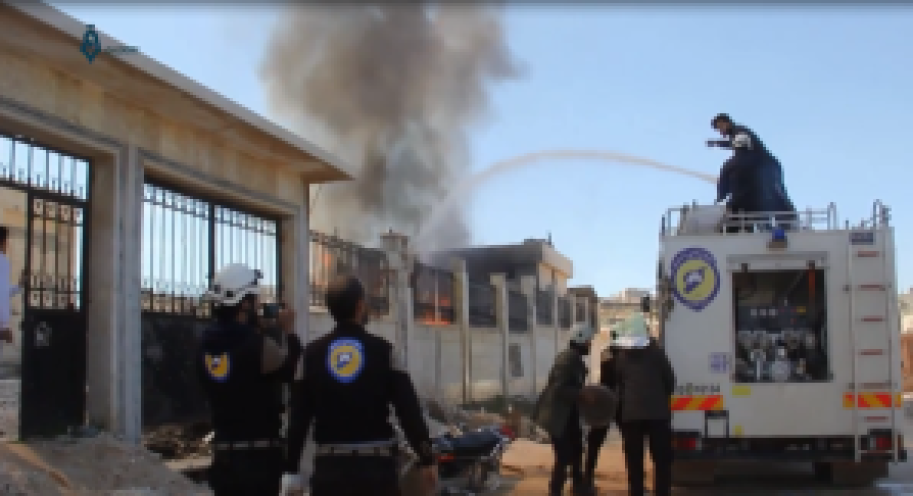
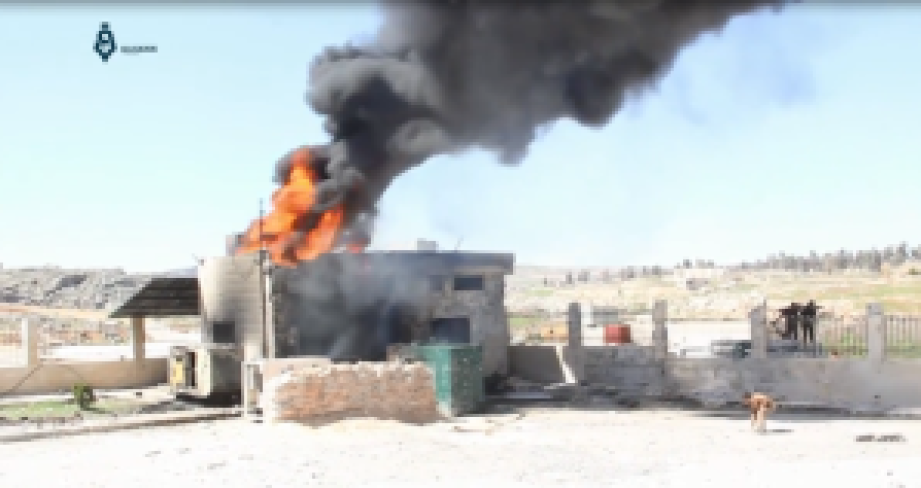
Photo of the fire on the hospital’s territory dated March 25, 2017
Near the building, we have found a burned diesel generator which previously supplied the hospital with electricity. The generator was destroyed by fire on March 25, 2017. The following video shows that the generator is out of order. Hence the hospital is out of operation since March 2017.
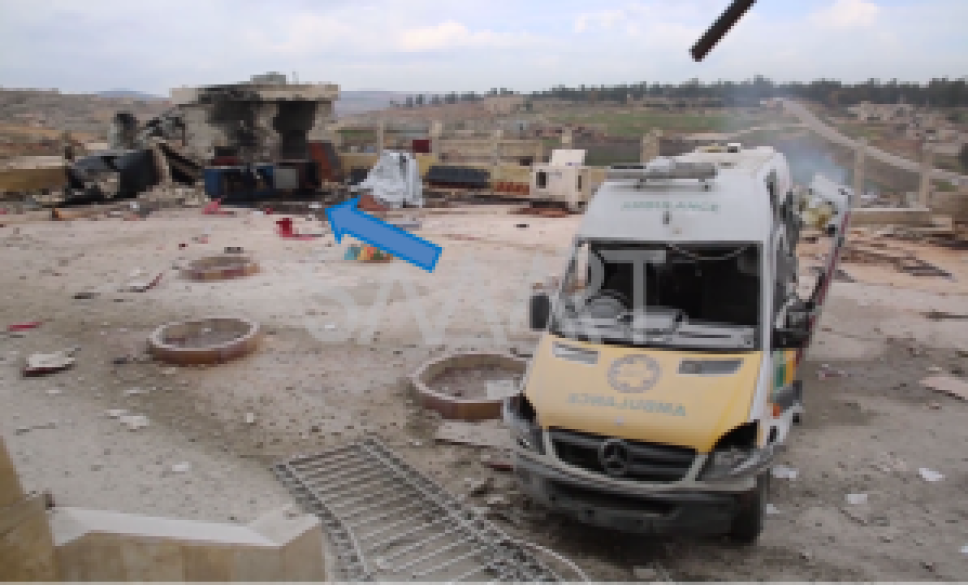
The territory of the hospital dated March 25, 2017.

Diesel generator destroyed by fire dated March 25, 2017.
Apparently, the medical personnel left the building much earlier. The latest evidence that the hospital operates for its intended purpose is a video dated May 17, 2014.

Video of the working hospital dated May 17, 2014.
On May 25, 2014, the hospital was attacked and partially destroyed.
After that, it seems that it was occupied by militia groups that used the hospital building as their base. The video shows a special mound (1) that covers the windows; there are no windows in the entire building (2); there are grills (3) installed at the entrance and indoor; the defensive positions are based on the second floor (4).
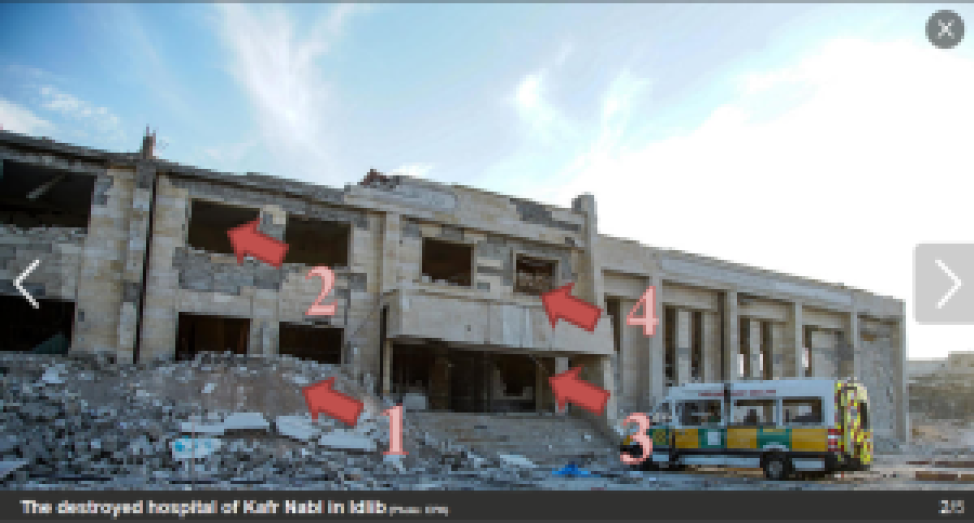
Photo of the destroyed hospital in Kafr-Nabl in the province of Idlib
The hospital current state shows that there was a serious fight for the building, perhaps between local opposition groups. The walls have multiple bullets holes.
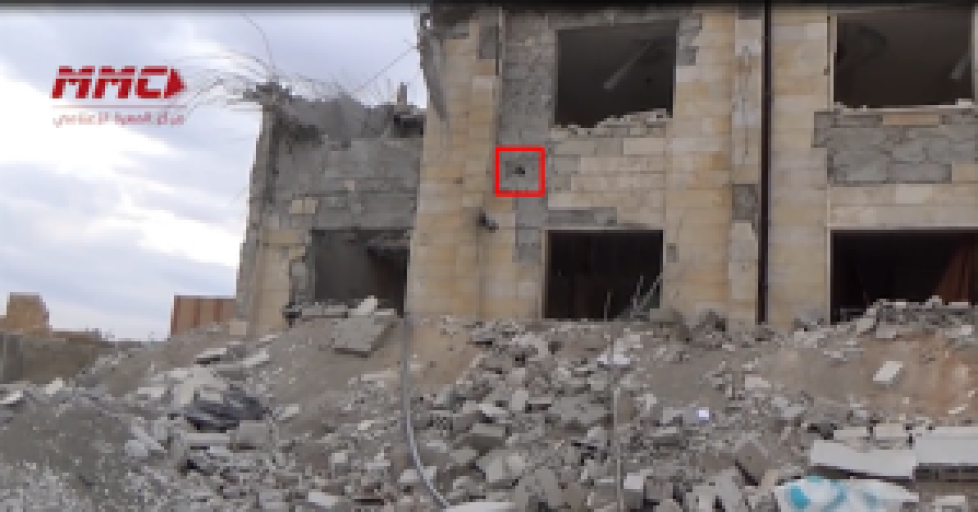

Photos of bullet holes
There are other burned buildings nearby that rather look like fortified positions of militants. Some of those buildings were seriously hit by artillery shells. Here is a small structure that has also been converted into a fire position after being partially destroyed.
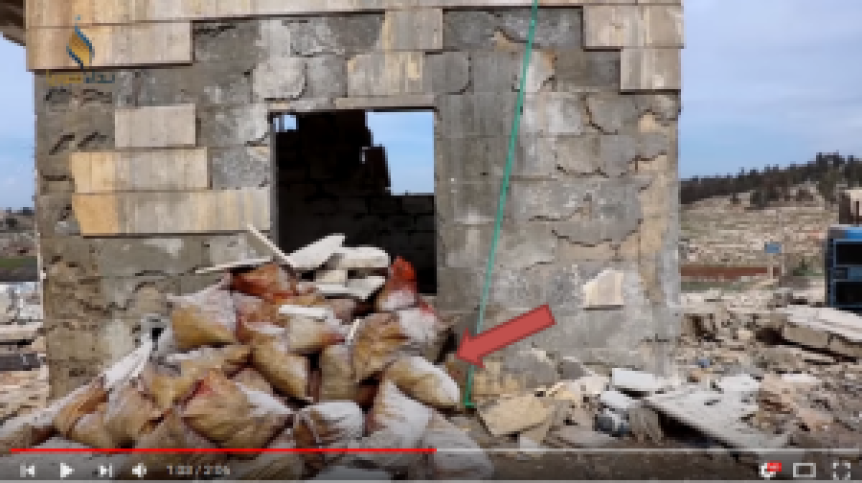
A small structure in the territory of the medical center
The mentioned facts point out that Kafr Nabl hospital was already out of operation as of February 5, 2018.
Another curious detail is that an ambulance parked in front of the building has exactly the same location in each video dating from September 19, 2017.

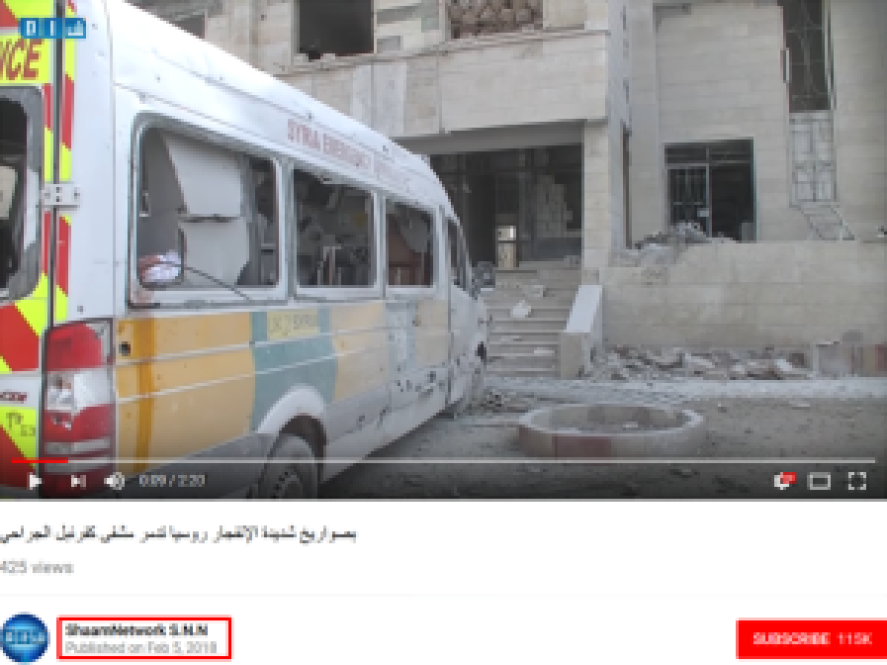
The same ambulance is always parked in the same place in the video posted on September 19, 2017, and in the one dated February 5, 2018
Moreover, there is no fragment of glass around or in the vehicle which means that the ambulance, with no equipment inside the cabin, by the way, was more likely to have been damaged long before the strike cited by the Guardian.

The ambulance cabin in the video dated February 5, 2018
Here’s another odd: rescuers are carrying out only two injured persons with no trace of dust on them. It means that these patients had been moved there to make a staged video about the aftermath of “an airstrike” on the hospital in February 2018. The footage doesn’t show a real rescue operation through the hospital allegedly treats up to 200, 000 patients a year!

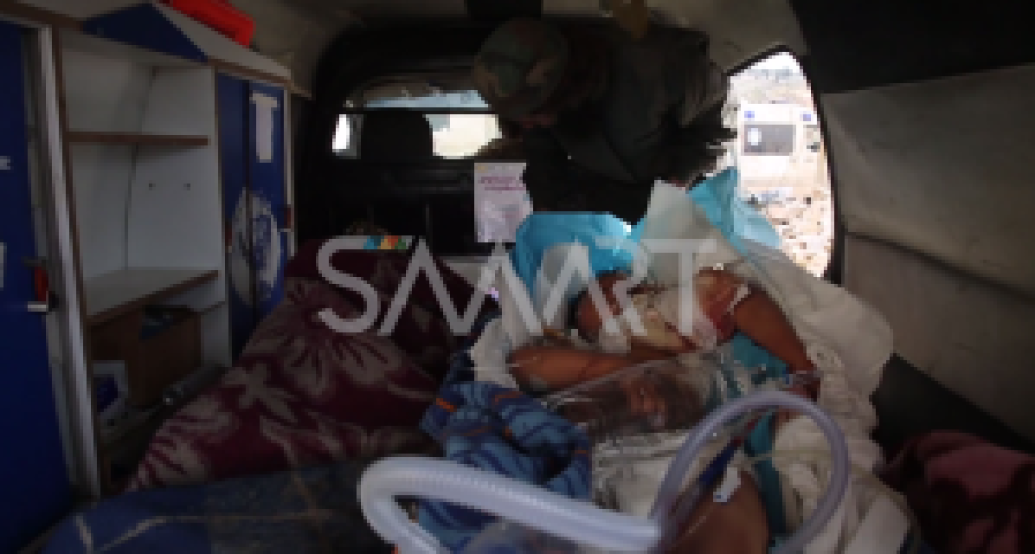
Staged video with two hospitals “patients”
Thus, the claims about the hospital bombing are clearly a hoax. Speaking of the Maarat al-Numan hospital we can say that its interior also looks doubtful as there’s no wall damage while the hospital rooms and halls don’t seem to be used for treatment: many of them are full with trash and lack medical equipment.

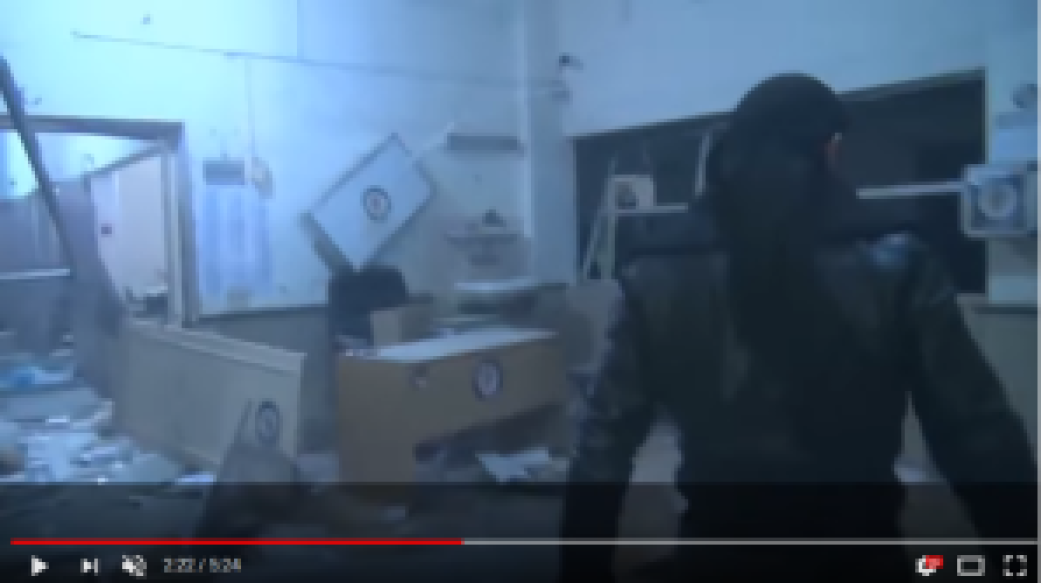
Rooms and halls in Maaret al-Numan hospital
Besides, one shot demonstrating the so-called bombing aftermath shows no material damage, dust or any other effect from an alleged air strike. And then, in other shots (2 min 12 sec) with the very same hospital after an “air strike”, the doors are pulled off and the building is damaged.
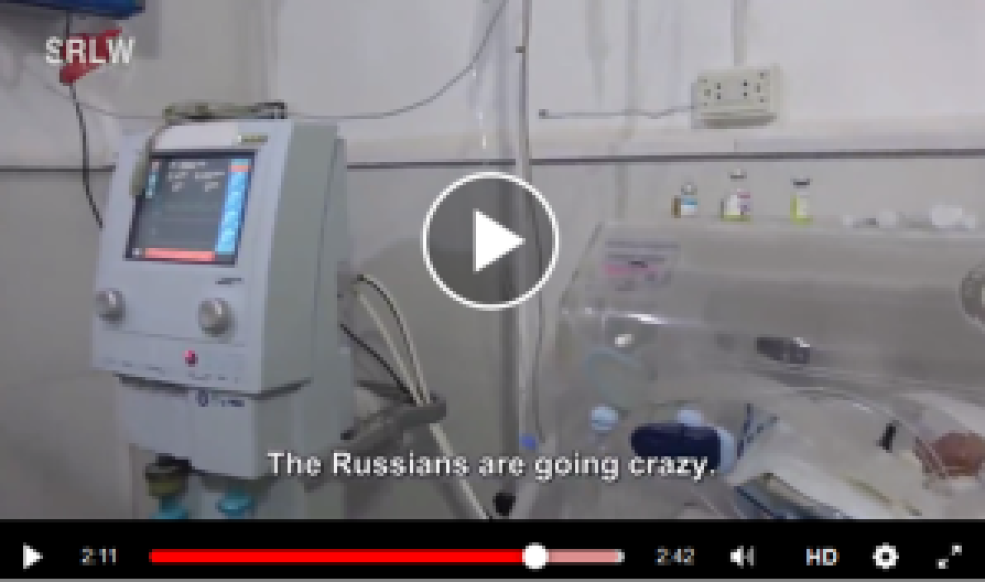
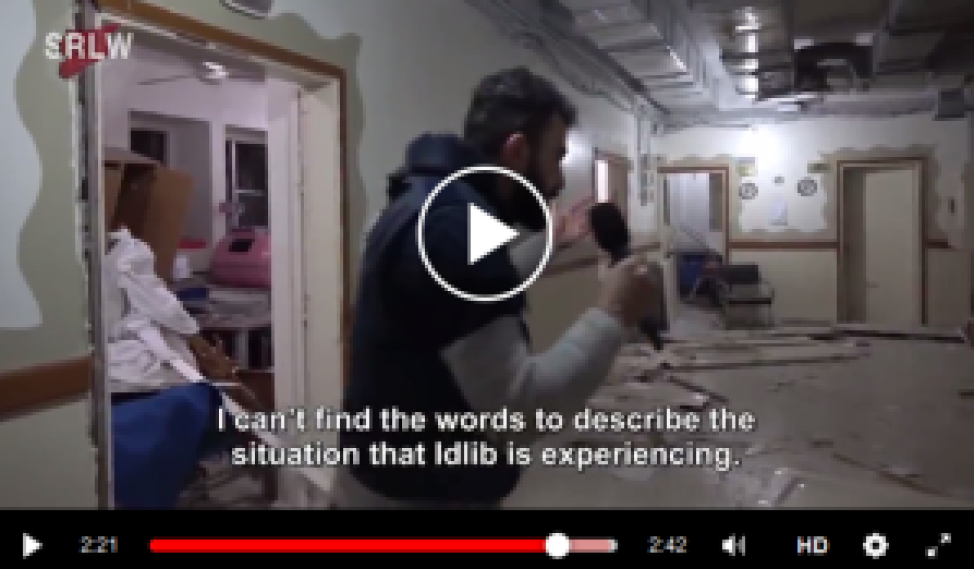
Medical equipment keep operating after an air strike
All this raises doubts about the veracity of information sourced from the director of safety and security at the Union of Medical Care and Relief Organisations Ahmad al-Dbis and the activist Hassan Mukhtar cited by the Guardian. For instance, Hassan Mukhtar claims there are 300 civilian deaths in two cities without mentioning his sources. But the most unbelievable is that how “the activist” could get information on “600,000 refugees trying to find a safe haven towards the Turkish border” in such short period of time.
Summary
We’ve found out the following inconsistent facts, which are more likely to be concocted:
– The number of air strikes launched from Feb. 4 to Feb. 5, 2018, and the number of towns in Idlib province allegedly damaged due to the raids
– Information about civilian deaths in the village of Termala
– Data about a chemical attack on the town of Saraqeb
– Information about air strikes on the hospitals in Kafr Nabl and Maarat al-Numan
– The craters created by bombs
– Lack of warhead fragments in the craters
Based on the investigation, it comes clear that the largest Western media, like the Guardian, tried to cover a new provocative initiative concocted by the Syrian opposition and the White Helmets backed by the U.S. special services and their allies who seek to discredit the Assad government, Syria’s and Russia’s Air Forces
